A Machine Learning Approach for Path Loss Prediction Using Combination of Regression and Classification Models
Abstract
1. Introduction
2. The Proposed Approach
2.1. Overview
2.2. Input and Output Parameters
2.3. Architectures of the Individual Models
3. Experimental Results
3.1. Experimental Dataset
3.2. Training and Validation
3.3. Testing and Performance Evaluation
4. Discussion
- With five properly selected input parameters, the proposed compound model demonstrates satisfactory prediction performance ( dB and ) for its practical application. This is valid for different antenna heights, various area types (rural, suburban, and urban), and for both LOS/NLOS scenarios;
- With an appropriate combination of simplified ordinary neural structures with relatively small number of layers, a satisfactory prediction accuracy can be achieved that is comparable to the one reported in other similar studies;
- The two regression models also have high prediction accuracy ( of dB and dB). These values of the are comparable to those reported in [33]. The models can be used separately when LOS/NLOS scenarios are predetermined;
- The used input parameters are easy to obtain and calculate;
- The achieved results are characterized with a high degree of confidence, considering the size and representativeness of the dataset (nearly 4500 measurement records for urban, suburban, and rural areas);
- The binary classifier is the bottleneck of the compound model’s performance. If this classifier is refined, the predictive accuracy will approach that of the individual regression models.
- 2D distance between antennas: ;
- Effective antenna height: ;
- Urban/suburban/rural environments;
- Brick and reinforced concrete buildings in urban and suburban areas;
- Flat/foothill/mountain/hilly relief types;
- Areas with humid continental climate;
- Operating frequency: .
5. Conclusions
Author Contributions
Funding
Institutional Review Board Statement
Informed Consent Statement
Data Availability Statement
Conflicts of Interest
Abbreviations
| IoT | Internet of Things |
| IoE | Internet of Everything |
| ML | Machine learning |
| MAC | Media access control |
| RLC | Radio link control |
| SVR | Support vector regression |
| RBF | Radial basis function |
| ANN | Artificial neural network |
| MLP | Multi-layer perceptron |
| GP | Gaussian process |
| ISM | Industrial, scientific, and medical |
| M2M | Machine-to-machine |
| LPWAN | Low-Power Wide-Area Network |
| LOS | Line-of-sight |
| NLOS | Non-line-of-sight |
| GIS | Geographic Information System |
| UART | Universal asynchronous receiver–transmitter |
| SMOTE | Synthetic Minority Oversampling Technique |
| ROC | Receiver operating curve |
References
- Green, D.; Yun, Z.; Iskander, M.F. Path Loss Characteristics in Urban Environments Using Ray-Tracing Methods. IEEE Antennas Wirel. Propag. Lett. 2017, 16, 3063–3066. [Google Scholar] [CrossRef]
- Qian, J.; Wu, Y.; Saleem, A.; Zheng, G. Path Loss Model for 3.5 GHz and 5.6 GHz Bands in Cascaded Tunnel Environments. Sensors 2022, 22, 4524. [Google Scholar] [CrossRef] [PubMed]
- Longley, A.; Rice, P. Prediction of Tropospheric Radio Transmission Loss Over Irregular Terrain: A Computer Method-1968; ESSA Technical Report; Institute for Telecommunication Sciences: Boulder, CO, USA, 1968. [Google Scholar]
- Iliev, I.G.; Bonev, B.G. Propagation Loss Model for Mobile Wireless Communication Systems. In Proceedings of the 2022 57th International Scientific Conference on Information, Communication and Energy Systems and Technologies (ICEST), Ohrid, North Macedonia, 16–18 June 2022; pp. 1–4. [Google Scholar] [CrossRef]
- Faruk, N.; Popoola, S.I.; Surajudeen-Bakinde, N.T.; Oloyede, A.A.; Abdulkarim, A.; Olawoyin, L.A.; Ali, M.; Calafate, C.T.; Atayero, A.A. Path Loss Predictions in the VHF and UHF Bands Within Urban Environments: Experimental Investigation of Empirical, Heuristics and Geospatial Models. IEEE Access 2019, 7, 77293–77307. [Google Scholar] [CrossRef]
- ETSI. Study on Channel Model for Frequencies from 0.5 to 100 GHz, Technical Report 3GPP TR 38.901 version 16.1.0 Release 16 ; European Telecommunications Standards Institute: Valbonne, France, 2020. [Google Scholar]
- Rappaport, T. Wireless Communications: Principles and Practice, 2nd ed.; Prentice Hall PTR: Paramus, NJ, USA, 2001. [Google Scholar]
- Dalela, C. Tuning Of Cost-231 Hata Model for Radio Wave Propagation Predictions. In Proceedings of the The Second International Conference on Computer Science, Engineering and Applications, Delhi, India, 25–27 May 2012; Volume 2, pp. 255–267. [Google Scholar] [CrossRef]
- Har, D.; Watson, A.; Chadney, A. Comment on diffraction loss of rooftop-to-street in COST 231-Walfisch-Ikegami model. IEEE Trans. Veh. Technol. 1999, 48, 1451–1452. [Google Scholar] [CrossRef]
- Lee, W.C.Y. Mobile Communications Design Fundamentals, 2nd ed.; John Wiley & Sons, Inc.: Hoboken, NJ, USA, 1992. [Google Scholar]
- Jo, H.S.; Park, C.; Lee, E.; Choi, H.K.; Park, J. Path Loss Prediction Based on Machine Learning Techniques: Principal Component Analysis, Artificial Neural Network, and Gaussian Process. Sensors 2020, 20, 1927. [Google Scholar] [CrossRef] [PubMed]
- Nguyen, C.; Cheema, A.A. A Deep Neural Network-Based Multi-Frequency Path Loss Prediction Model from 0.8 GHz to 70 GHz. Sensors 2021, 21, 5100. [Google Scholar] [CrossRef] [PubMed]
- He, R.; Gong, Y.; Bai, W.; Li, Y.; Wang, X. Random Forests Based Path Loss Prediction in Mobile Communication Systems. In Proceedings of the 2020 IEEE 6th International Conference on Computer and Communications (ICCC), Chengdu, China, 11–14 December 2020; pp. 1246–1250. [Google Scholar] [CrossRef]
- Tahat, A.; Edwan, T.; Al-Sawwaf, H.; Al-Baw, J.; Amayreh, M. Simplistic Machine Learning-Based Air-to-Ground Path Loss Modeling in an Urban Environment. In Proceedings of the 2020 Fifth International Conference on Fog and Mobile Edge Computing (FMEC), Paris, France, 20–23 April 2020; pp. 158–163. [Google Scholar] [CrossRef]
- Saleh, T.; Petrov, D.; Tirkkonen, O.; Räisänen, V. Probabilistic Path Loss Predictors for mmWave Networks. In Proceedings of the 2021 IEEE 93rd Vehicular Technology Conference (VTC2021-Spring), Virtual, 25–28 April 2021; pp. 1–6. [Google Scholar] [CrossRef]
- Kwon, B.; Son, H. Accurate Path Loss Prediction Using a Neural Network Ensemble Method. Sensors 2024, 24, 304. [Google Scholar] [CrossRef] [PubMed]
- Ojo, S.; Sari, A.; Ojo, T. Path Loss Modeling: A Machine Learning Based Approach Using Support Vector Regression and Radial Basis Function Models. Open J. Appl. Sci. 2022, 12, 990–1010. [Google Scholar] [CrossRef]
- George, G.; Idogho, J. Path loss prediction based on machine learning techniques: Support vector machine, artificial neural network, and multi linear regression model. J. Phys. Sci. 2022, 3, 1–22. [Google Scholar] [CrossRef]
- Elmezughi, M.; Salih, O.; Afullo, T.; Duffy, K. Path loss modeling based on neural networks and ensemble method for future wireless networks. Heliyon 2023, 9, e19685. [Google Scholar] [CrossRef] [PubMed]
- Elmezughi, M.K.; Salih, O.; Afullo, T.J.; Duffy, K.J. Comparative Analysis of Major Machine-Learning-Based Path Loss Models for Enclosed Indoor Channels. Sensors 2022, 22, 4967. [Google Scholar] [CrossRef] [PubMed]
- Turan, B.; Coleri, S. Machine Learning Based Channel Modeling for Vehicular Visible Light Communication. IEEE Trans. Veh. Technol. 2021, 70, 9659–9672. [Google Scholar] [CrossRef]
- Popoola, S.I.; Atayero, A.A.; Arausi, O.D.; Matthews, V.O. Path loss dataset for modeling radio wave propagation in smart campus environment. Data Brief 2018, 17, 1062–1073. [Google Scholar] [CrossRef] [PubMed]
- OSM Buildings. 2024. Available online: https://osmbuildings.org (accessed on 28 August 2024).
- Manca, V. Artificial Neural Network Learning, Attention, and Memory. Information 2024, 15, 387. [Google Scholar] [CrossRef]
- Dubey, S.R.; Singh, S.K.; Chaudhuri, B.B. Activation Functions in Deep Learning: A Comprehensive Survey and Benchmark. arXiv 2022, arXiv:cs.LG/2109.14545. [Google Scholar] [CrossRef]
- Cortes, C.; Mohri, M.; Rostamizadeh, A. L2 Regularization for Learning Kernels. In Proceedings of the 25th Conference on Uncertainty in Artificial Intelligence, UAI 2009, Montreal, QC, Canada, 18–21 June 2009. [Google Scholar]
- Semtech Corporation. SX1276/77/78/79—137 MHz to 1020 MHz Low Power Long Range Transceiver, 2020. Rev. 7 – May 2020. Available online: https://semtech.my.salesforce.com/sfc/p/#E0000000JelG/a/2R0000001Rbr/6EfVZUorrpoKFfvaF_Fkpgp5kzjiNyiAbqcpqh9qSjE (accessed on 5 September 2024).
- Huggins, J.S. Mast Mountable Antenna. U.S. Patent US20170201002A1, 13 July 2017. [Google Scholar]
- Ellingson, S.W. The modified j-pole: A wideband end-fed half-wave dipole for a VHF reflector feed system. In Proceedings of the 2017 IEEE International Symposium on Antennas and Propagation & USNC/URSI National Radio Science Meeting, San Diego, CA, USA, 9–14 July 2017; pp. 773–775. [Google Scholar] [CrossRef]
- Chawla, N.V.; Bowyer, K.W.; Hall, L.O.; Kegelmeyer, W.P. SMOTE: Synthetic Minority Over-sampling Technique. J. Artif. Intell. Res. 2002, 16, 321–357. [Google Scholar] [CrossRef]
- Noel, M.M.; Banerjee, A.; D, G.B.A.; Muthiah-Nakarajan, V. Alternate Loss Functions for Classification and Robust Regression Can Improve the Accuracy of Artificial Neural Networks. arXiv 2023, arXiv:cs.NE/2303.09935. [Google Scholar]
- Wu, D.; Zhu, G.; Ai, B. Application of artificial neural networks for path loss prediction in railway environments. In Proceedings of the 2010 5th International ICST Conference on Communications and Networking in China, Beijing, China, 25–27 August 2010; pp. 1–5. [Google Scholar]
- Phillips, C.; Sicker, D.; Grunwald, D. Bounding the error of path loss models. In Proceedings of the 2011 IEEE International Symposium on Dynamic Spectrum Access Networks (DySPAN), Chennai, India, 28 February–3 March 2011; pp. 71–82. [Google Scholar] [CrossRef]



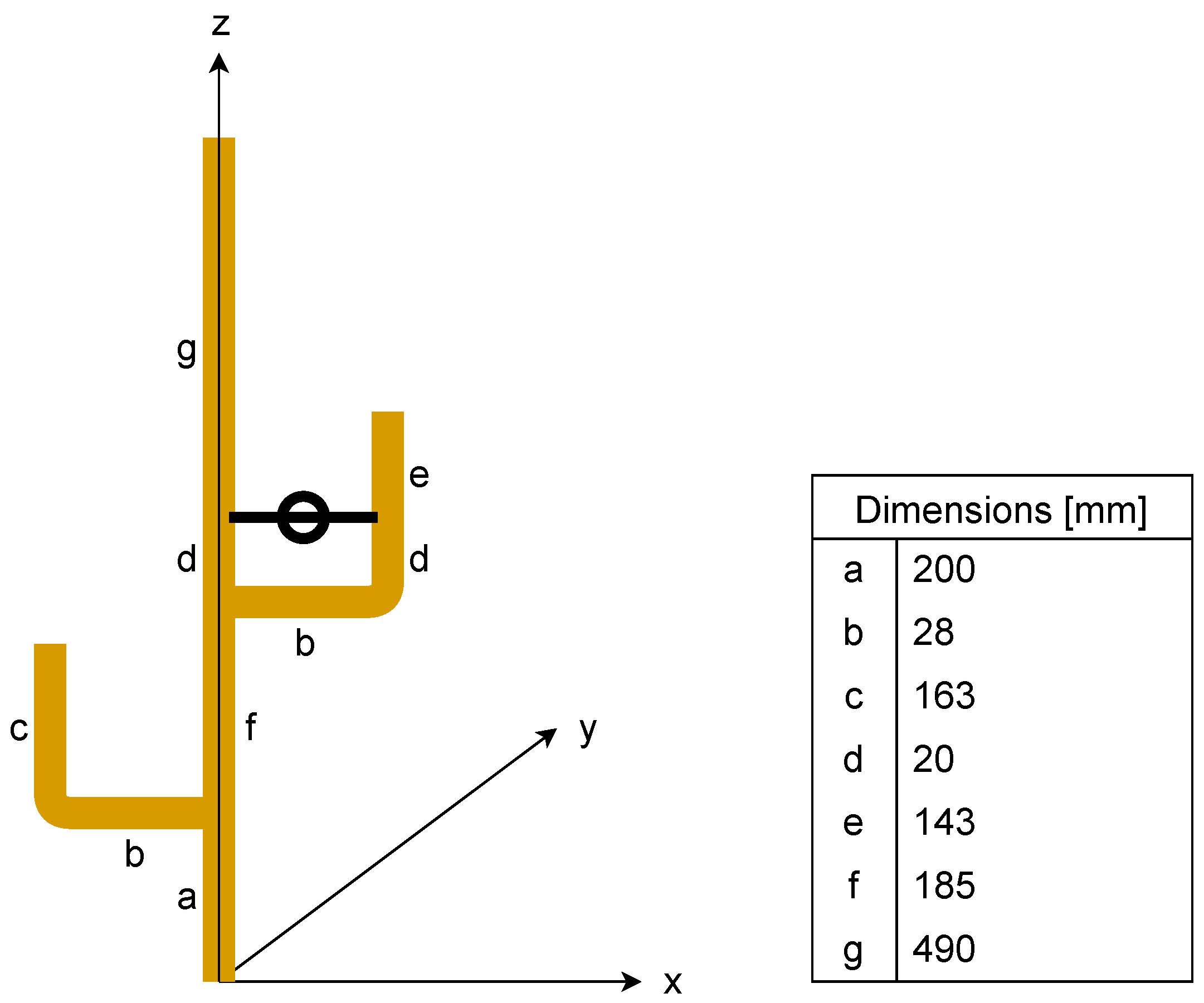
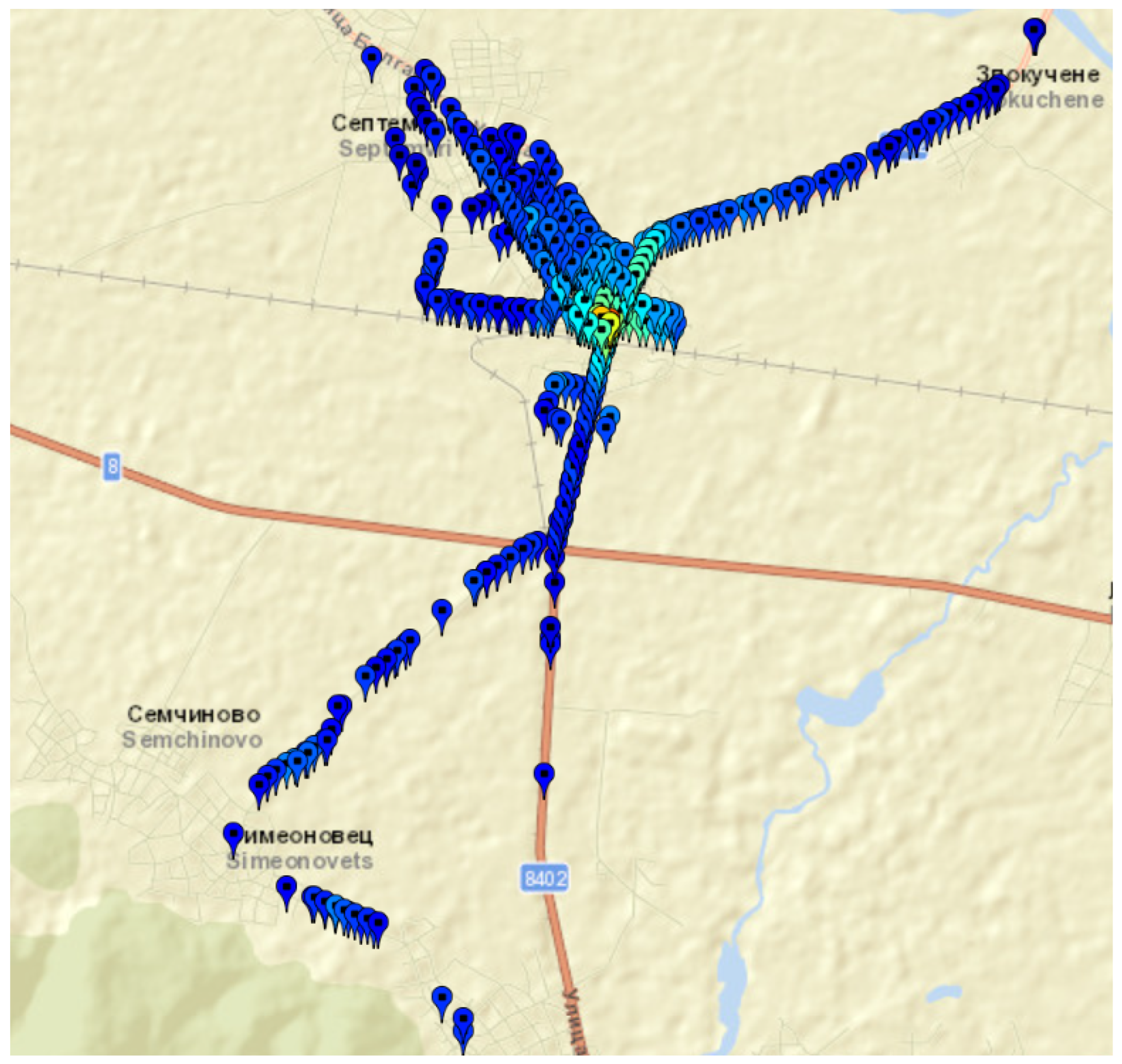





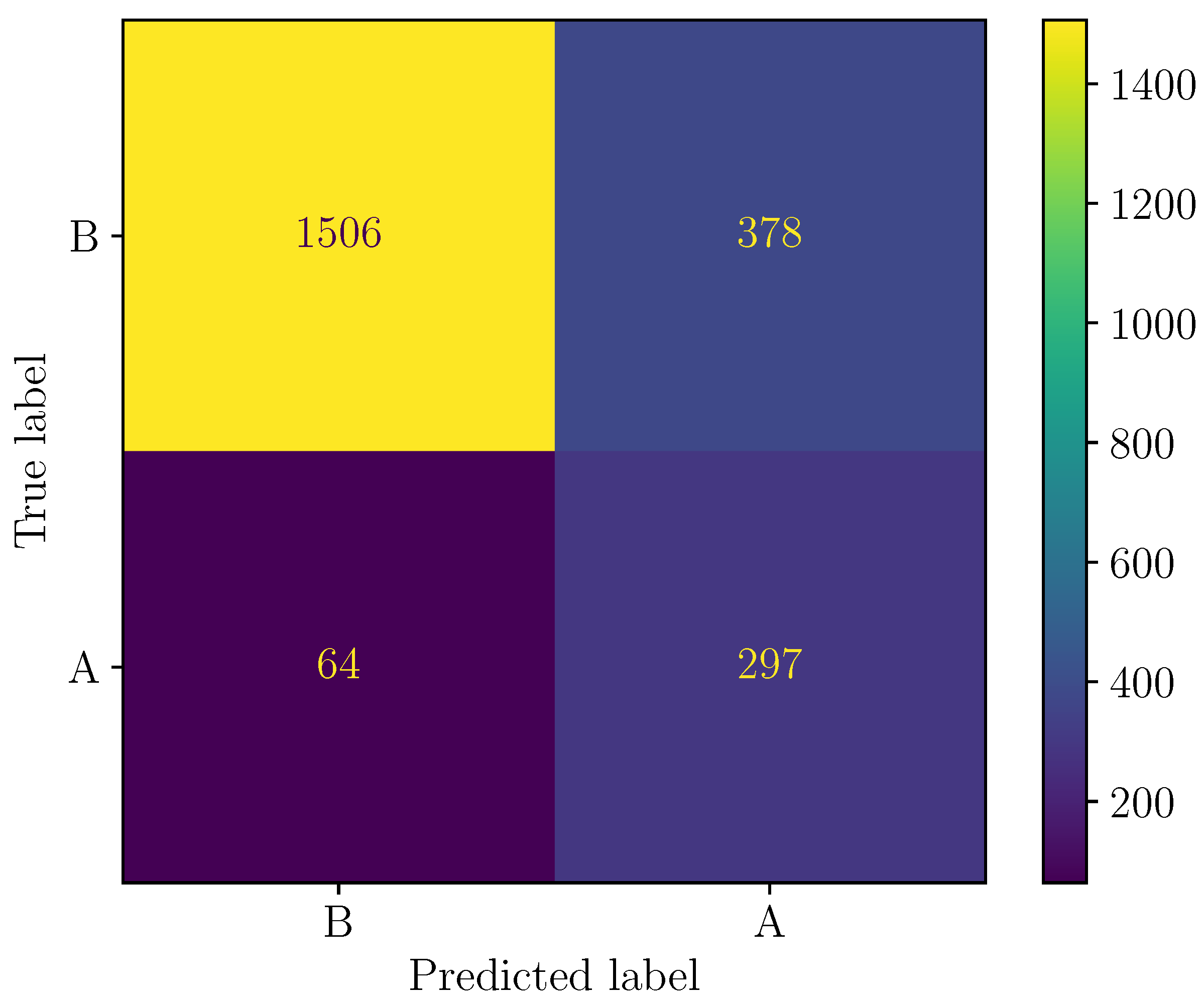
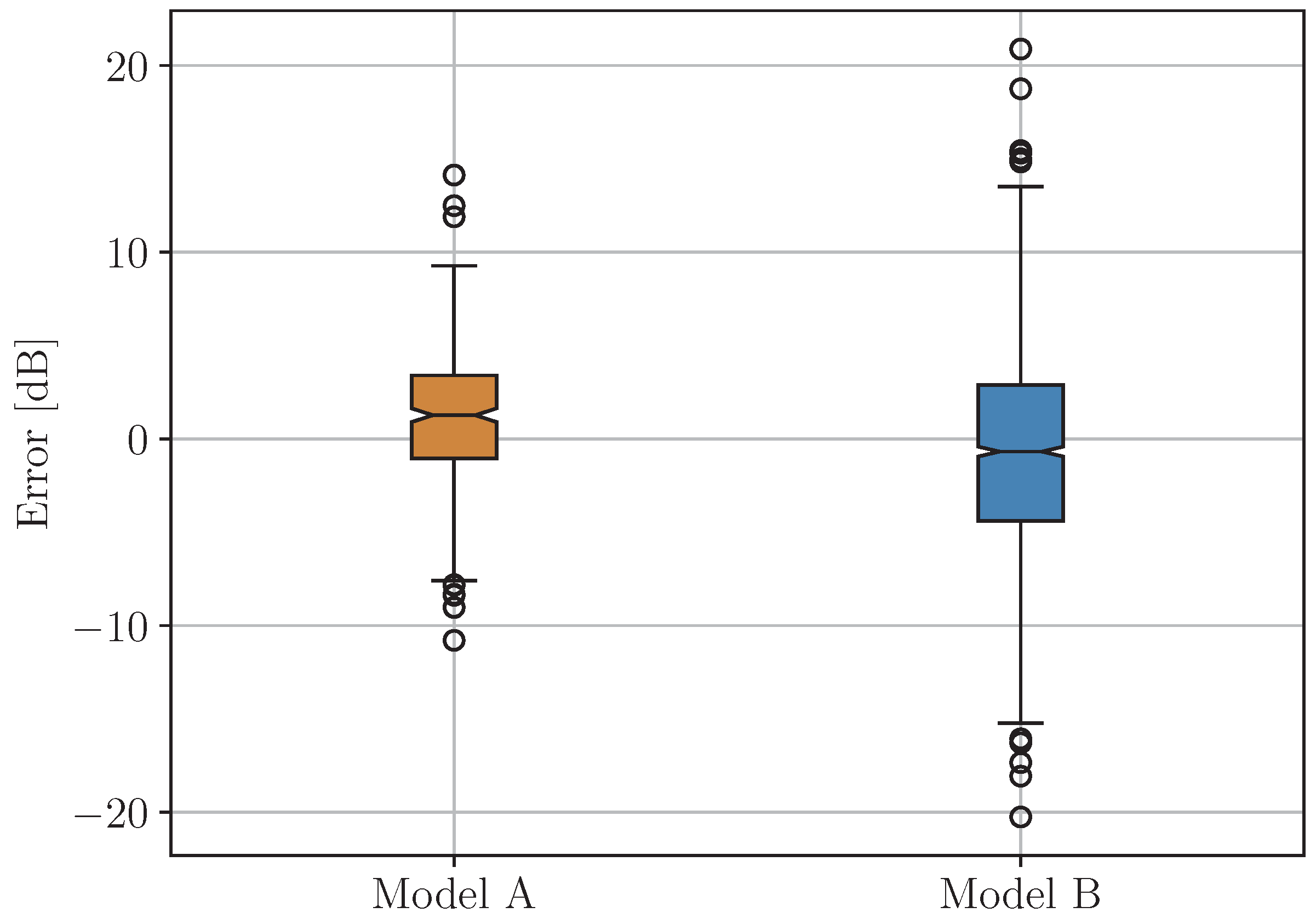


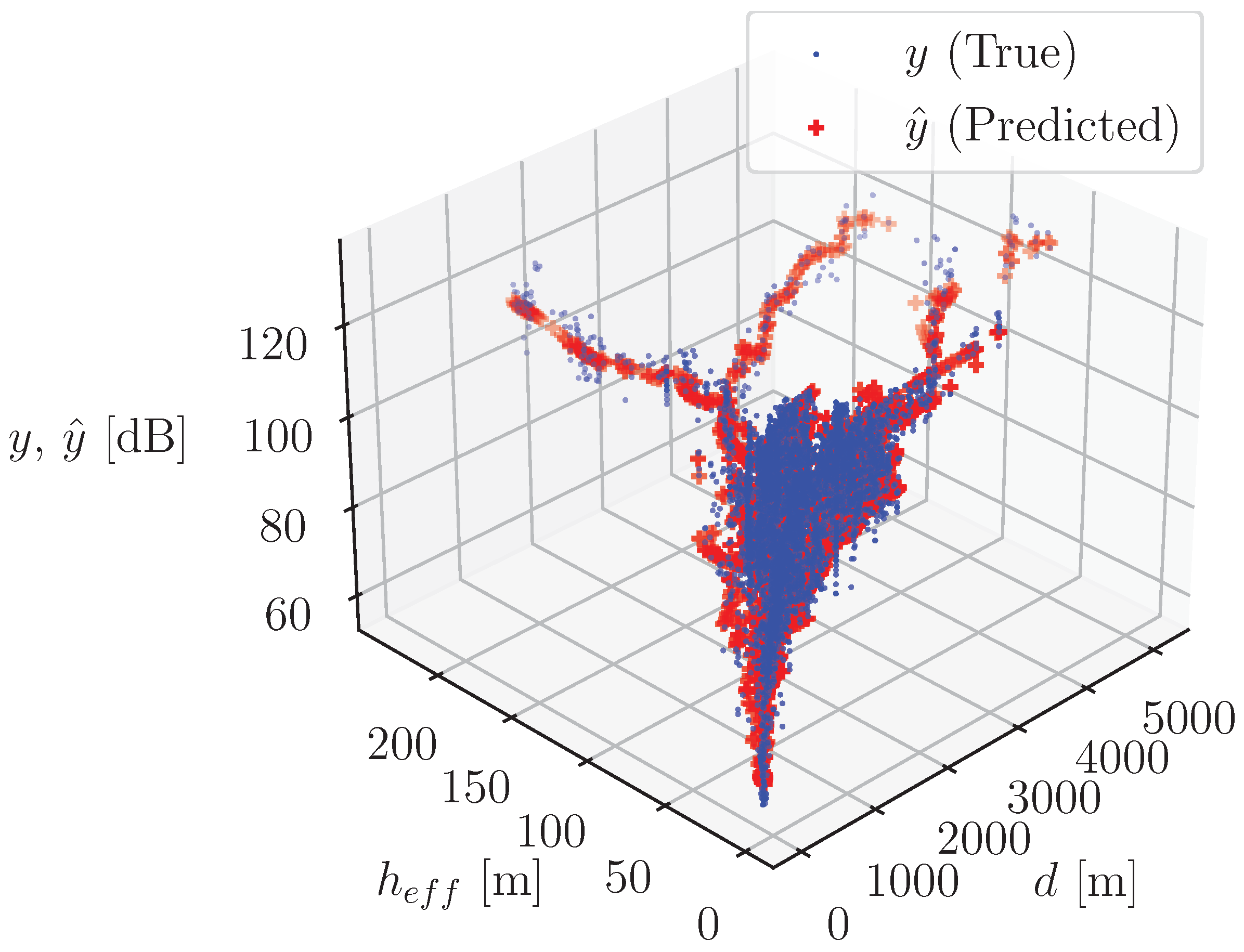
| Area | Coordinates | Antenna Height | Area Type | Relief Type | Average Buildings’ Height | Maximum Terrain Unevenness | Maximum Measurement Distance |
|---|---|---|---|---|---|---|---|
| Septemvri town Bulgaria | lat. 42.20447 lng. 24.13740 alt. 240 m | 8 (mounted on the roof of a brick building) | Rural, suburban | Flat | 7 | 95 | 4824 |
| Belogradchik town, Bulgaria | lat. 43.62802 lng. 22.68377 alt. 500 m | 8 (mounted on the 3rd floor of a brick building) | Rural, suburban | Hilly | 16 | 240 | 5150 |
| Sofia city, Bulgaria, Campus of the Technical University of Sofia | lat. 43.65518 lng. 23.35418 alt. 596 m | 8.5, 12, 15.5, 19, 25.5 (mounted on the roof) | Suburban, urban | Flat, mountain, foothill | 12 | 28 | 1784 |
| Sofia city, Bulgaria, res. area Darvenitza | lat. 42.65676 lng. 23.34264 alt. 595 m | 6.25, 9.75, 30 | Urban, suburban | Flat, mountain, foothill | 24 | 19 | 1152 |
| Model | |||||
|---|---|---|---|---|---|
| Model A | 0.930 | dB (4.45%) | dB (3.33%) | dB (0.98%) | dB (4.34%) |
| Model B | 0.739 | dB (4.90%) | dB (3.77%) | dB (−0.87%) | dB (4.82%) |
| Compound | |||||
| with “soft” | |||||
| combination | 0.702 | dB (6.87%) | dB (4.81%) | dB (1.29%) | dB (6.75%) |
| Compound | |||||
| with “hard” | |||||
| combination | 0.604 | dB (7.89%) | dB (5.36%) | dB (1.14%) | dB (7.75%) |
| Method/Approach | |||
|---|---|---|---|
| ANN, ensemble learning 1 [16] | 0.8951 | dB | dB |
| SVR 2 [17] | 0.8528 | dB | — |
| ANN-RBF 3 [17] | 0.8965 | dB | — |
| ANN-MLP 4 [11] | 0.3975 | dB | dB |
| ANN 5 [32] | 0.4168 | dB | dB |
| Proposed in this study 6 | 0.702 | dB | dB |
Disclaimer/Publisher’s Note: The statements, opinions and data contained in all publications are solely those of the individual author(s) and contributor(s) and not of MDPI and/or the editor(s). MDPI and/or the editor(s) disclaim responsibility for any injury to people or property resulting from any ideas, methods, instructions or products referred to in the content. |
© 2024 by the authors. Licensee MDPI, Basel, Switzerland. This article is an open access article distributed under the terms and conditions of the Creative Commons Attribution (CC BY) license (https://creativecommons.org/licenses/by/4.0/).
Share and Cite
Iliev, I.; Velchev, Y.; Petkov, P.Z.; Bonev, B.; Iliev, G.; Nachev, I. A Machine Learning Approach for Path Loss Prediction Using Combination of Regression and Classification Models. Sensors 2024, 24, 5855. https://doi.org/10.3390/s24175855
Iliev I, Velchev Y, Petkov PZ, Bonev B, Iliev G, Nachev I. A Machine Learning Approach for Path Loss Prediction Using Combination of Regression and Classification Models. Sensors. 2024; 24(17):5855. https://doi.org/10.3390/s24175855
Chicago/Turabian StyleIliev, Ilia, Yuliyan Velchev, Peter Z. Petkov, Boncho Bonev, Georgi Iliev, and Ivaylo Nachev. 2024. "A Machine Learning Approach for Path Loss Prediction Using Combination of Regression and Classification Models" Sensors 24, no. 17: 5855. https://doi.org/10.3390/s24175855
APA StyleIliev, I., Velchev, Y., Petkov, P. Z., Bonev, B., Iliev, G., & Nachev, I. (2024). A Machine Learning Approach for Path Loss Prediction Using Combination of Regression and Classification Models. Sensors, 24(17), 5855. https://doi.org/10.3390/s24175855











